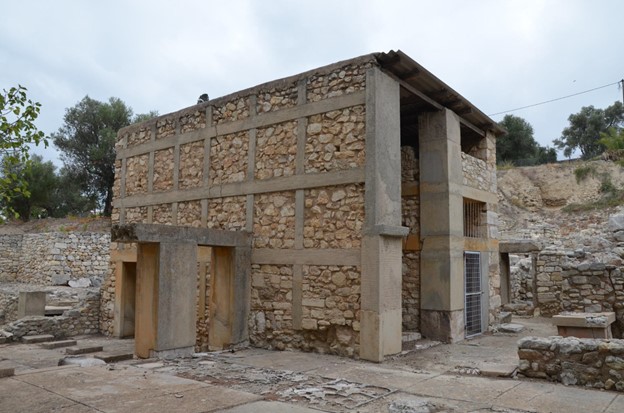
Restoration Works for Small Palace of Knossos
Table of Contents
Introduction
Void of the vibrant whispers of worship and royal echoes, the archaeological edifices that clasp a civilization’s soul in Crete are often a tapestry sketched by wind-worn time. But there’s one iridescent thread, meticulously woven back into its ancient glory, inviting a new narrative of resilience and reverence, the Small Palace of Knossos.
This article reveals the enthralling tale of how this piece of antiquity is being meticulously touched by the sure hand of restoration – a beacon for history enthusiasts, a sanctuary for the curious, and a milestone for archaeology.
Rediscovering Knossos’ Hidden Gem

The Small Palace of Knossos, shadowed by the fame of the Grand Palace, holds its unique place in the tapestry of Minoan civilization.
Situated just to the west of the Grand Palace, this structure is believed to have been constructed around the same time, circa 1700-1450 BC, signifying its role in the complex social and political landscape of ancient Crete.
Its historical significance is underscored by its architectural innovation and the artifacts unearthed within its confines, offering insights into the daily lives, religious practices, and administrative workings of the Minoan people.
The presence of sophisticated frescoes, intricate pottery, and advanced drainage systems within the palace walls speaks to the advanced state of Minoan culture and craftsmanship, further highlighting the civilization’s importance in the broader scope of Aegean history.
In the annals of archaeology, the Small Palace of Knossos is celebrated not just for its structural or artistic merits but also for its narrative of resilience. The palace is known to have sustained considerable damage from the cataclysmic eruption of Thera (Santorini) around 1600 BC and was subsequently rebuilt.
This event, along with successive occupations and reconstructions, layered the palace with a rich historical patina, offering scholars a chronological depth in their quest to understand the Minoan epoch.
Though less grandiose than its larger counterpart, the Small Palace’s archaeological footprint provides a compelling glimpse into the complexity and dynamism of Crete’s ancient society, underscoring its significance as a center of cultural and economic power in the ancient world
Reveling in the Restoration

The ongoing restoration efforts at the Small Palace of Knossos, particularly at the “Staircase” and the “Drainage Cistern,” exemplify a meticulous approach to preserving the architectural integrity and historical significance of the Minoan civilization.
With the Small Palace strategically located to the northwest of the grand Knossos Palace, connected by the so-called “Royal Road,” these interventions serve not only as structural reinforcements but as pivotal efforts in bridging the physical and cultural narratives of ancient Crete.
Minister of Culture, Lina Mendoni, emphasized the importance of these restorations as integral components of the broader initiative to nominate the Minoan Palace Centers for serial inscription on the UNESCO World Heritage List.
Her remarks underscore the Small Palace’s role as an essential monument, organically intertwined with the main palace complex, highlighting the comprehensive plan aimed at bolstering the archaeological site’s resilience and enhancing the visitor experience.
The “Staircase,” an exemplary model of Minoan architectural innovation, is undergoing significant restoration, including the closure of existing openings (excluding the entrance), stitching of cracks, and the construction of a new roof.
These efforts aim to address damages caused by wind erosion and rainfall, ensuring the preservation of this historically significant edifice.
Similarly, the “Drainage Cistern,” a critical feature underlining the Minoan mastery in civil engineering and its religious significance, is receiving attention to restore damage and protect the unique imprints of ribbed wooden columns held within the Minoan mortar.
The restoration of the “Staircase” and the “Drainage Cistern” not only reflects the commitment to safeguarding the architectural and historical fabric of the Small Palace but also showcases the intricate balance between modern restoration techniques and the respect for traditional Minoan craftsmanship.
These interventions, grounded in decades of archaeological research and heritage management, contribute to our understanding of the Minoan civilization’s complexity and its enduring legacy in the realm of Aegean archaeology.
A Comparative Analysis of Minoan Marvels

The Small Palace of Knossos and the Grand Palace stand as testament to the grandeur and sophistication of the Minoan civilization, each reflective of its unique role in ancient society.
While the Grand Palace is often celebrated for its expansive scale and complexity, indicative of its central role in Minoan culture and administration, the Small Palace offers a different, yet equally significant, insight into Minoan life.
The architectural design of the Grand Palace, with its multifaceted layers of rooms, courtyards, and ceremonial spaces, showcases the pinnacle of Minoan architectural innovation and the complexity of their societal structure. In contrast, the more modest size of the Small Palace does not diminish its historical significance.
Its construction, believed to be synchronous with the Grand Palace, suggests its integral role in the broader socio-political and religious fabric of Minoan Knossos.
While the Grand Palace is often acclaimed for its advanced features, such as the iconic frescoes, elaborate drainage systems, and sophisticated urban planning, the Small Palace similarly houses remarkable artifacts and architectural details.
These include intricate frescoes, pottery, and evidence of advanced hydroengineering, underscoring the technological and artistic achievements of the Minoan civilization.
The juxtaposition of these two monumental structures provides a comprehensive view of Minoan society’s complexity, from its administrative prowess and religious practices to its artistic and technological advancements.
Conclusion
In a world that often seems to slink towards a future untethered from the past, the Small Palace of Knossos’ story is a powerful reminder that our history is not a crutch but a trampoline. It propels us forward, armed with the wisdoms of yesteryears, to leap into a future that is nuanced, rich, and, most crucially, rooted.




